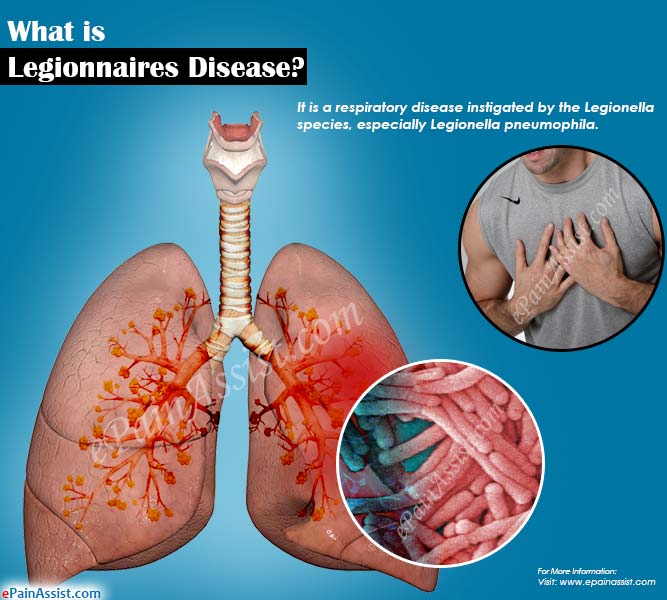Legionnaire’s disease is an uncommon member of the pneumonia family, which is caused due to the infection of Legionella species. The disease classically represents symptoms specific to pneumonia and diarrhea. It is an infection of the lungs that affects at least 8000 individuals each year.

What is Legionnaires Disease?
Legionnaire’s disease, also called Legionellosis is a respiratory disease instigated by the Legionella species, especially Legionella pneumophila. The bacteria is found in freshwater bodies like lakes, rivers and streams and it thrives especially in warm water. The infection primarily affects the lungs and the symptoms of this infection are same as that of pneumonia like high fever, shivers, muscle pain, headache, cough and diarrhea. Though the symptoms of pneumonia and legionellosis appear same; the legionellosis is more severe in comparison to pneumonia. This infection is of two types based on the severity which are:
- Legionnaires’ Disease: It is generally a fatal lung infection accompanied by severe illness.
- Pontiac Fever: It is a flu-like infection which is not much serious.
Individuals get infected from the legionnaire’s disease when the Legionella contaminated water mist is inhaled, but in most cases it is not a contagious disease. Legionnaire’s disease is known to cause persistence of fatigue, neurologic as well as neuromuscular ailments even after months, thus leading to long term impaired health.
Where did the Name Legionnaires Disease Come From?
The causative agent for the legionnaire’s disease, Legionella species were discovered at the 58th American Legion Annual Convention in 1976, in Philadelphia. The species was identified contaminating the air conditioning system of the venue which was the Bellevue-Stratford Hotel. The contamination recorded infection to over 180 individuals including the loss of 29 lives. The infection showed symptoms of mild flu but also caused multisystem organ failure. This incidence gave the bacterial strain its name as Legionella.
Signs and Symptoms of Legionnaires Disease
The Symptoms of Legionnaire’s disease tend to appear within a span of five to six days post the exposure. The symptoms are similar to that of flu but apart from this there are also a few other symptoms. These symptoms of legionnaire’s disease include:
- Dry Coughing
- Difficulty in catching breath
- High fever with temperature over 100 degree Fahrenheit.
- Chills and shivering
- Muscle pain and spasms
- Mild to severe headaches
- Fatigue
- Confusion and perplexity
- Renal failure (less common)
- Diarrhea.
How Do You Get Legionnaires Disease?
The legionnaire’s disease can be contracted through two ways, one being the inhalation of the Legionella contaminated mist droplets and the other being aspiration. In case of aspiration, when the individuals that smoke or have a lung disease get choked, their oral secretion tend to enter the lungs rather than into the stomach or esophagus, thereby allowing the bacteria to enter the lungs.
The common fresh water sources that pose a threat of the Legionella infection are un-drained hot tubs after usage, air conditioning units, hot water tanks and decorative fountains.
Pathophysiology of Legionnaires Disease
Legionella pneumophila are obligate parasites that grow and replicate within the cells. When the individuals are infected, these bacteria perform intracellular replication within the cells of alveoli which in turn activates the T-cells. The T-cells produce lymphokines which increasingly help in amplifying the antimicrobial activity of the macrophages. This thus, helps in checking the intracellular growth of the bacteria. In case of individuals with compromised immunity or individuals who smoke, the innate immunity is unable to cease the process of replication thus making them more vulnerable to legionnaire’s disease.
Diagnosis of Legionnaires Disease
The diagnostic measures followed in case of Legionnaire’s disease are:
- Urine Test to Detect Legionnaires Disease: It is the most commonly followed diagnostic procedure in which the Legionella antigens are detected in the urine to confirm the presence of Legionella infection.
- Sputum Test to Diagnose Legionnaires Disease: The sputum of phlegm sample from the lungs is cultured to analyze the presence of this bacterial infection.
- Chest X-ray to Identify Legionnaires Disease: The chest X-Ray is used to check for the abnormal densities present within the lungs. On the presence of the abnormal densities, the x-ray film appears white in the affected regions.
- Blood Test to Detect Legionnaires Disease: The blood test is conducted to check for the increase in white blood cell count, low sodium levels, decreased function of liver and kidneys, to check for the presence of the bacterial infection.
Treatment of Legionnaires Disease
The treatment of the Legionnaires’s disease solely depends on antibiotics and there is no vaccination to prevent the disease. There are primarily three major classes of antibiotics that are prescribed for the treatment of the Legionnaires’s disease. The type of antibiotic prescribed depends on the below factors:
- Clinical condition of the patient
- Tolerance levels of the patient
- Degree of certainty regarding the presence of the infection.
The different types of antibiotics that are prescribed are:
- Fluoroquniolones to Treat Legionnaires Disease: This class includes levofloxacin and moxifloxacin.
- Macrolides for Treating Legionnaires Disease: It includes erythromycin, azithromycin and clarithromycin.
- Tetracyclines to Treat Legionnaires Disease: It includes doxycyclines.
In cases when single antibiotic dosage does not provide the required relief then generally Rifampin is given along for better results.
Conclusion
Legionnaire’s disease is a bacterial infection caused by the Legionella species which enter the human body through the inhalation of the contaminated water droplets. The individuals with advanced age, history of smoking, prior presence of lung disease and compromised immune system are more susceptible to legionnaire’s disease. On infection, the legionnaire’s disease has initial symptoms resembling pneumonia but if left misdiagnosed can become fatal or lead to multiple organ failure. The symptoms usually appear in two to ten days after exposure. Once diagnosed, legionnaire’s disease can be treated through suitable antibiotic treatment.
- Centers for Disease Control and Prevention (CDC) – Legionnaires Disease: https://www.cdc.gov/legionella/about/index.html
- Mayo Clinic – Legionnaires Disease: https://www.mayoclinic.org/diseases-conditions/legionnaires-disease/symptoms-causes/syc-20351747
- American Lung Association – Legionnaires Disease: https://www.lung.org/lung-health-diseases/lung-disease-lookup/legionnaires-disease
Also Read:
